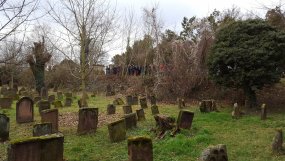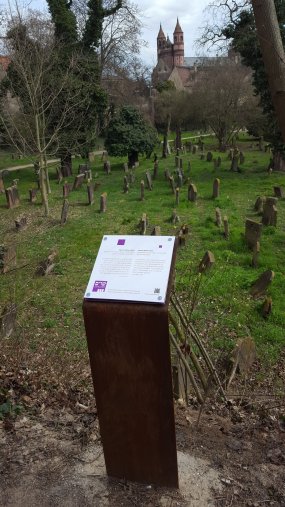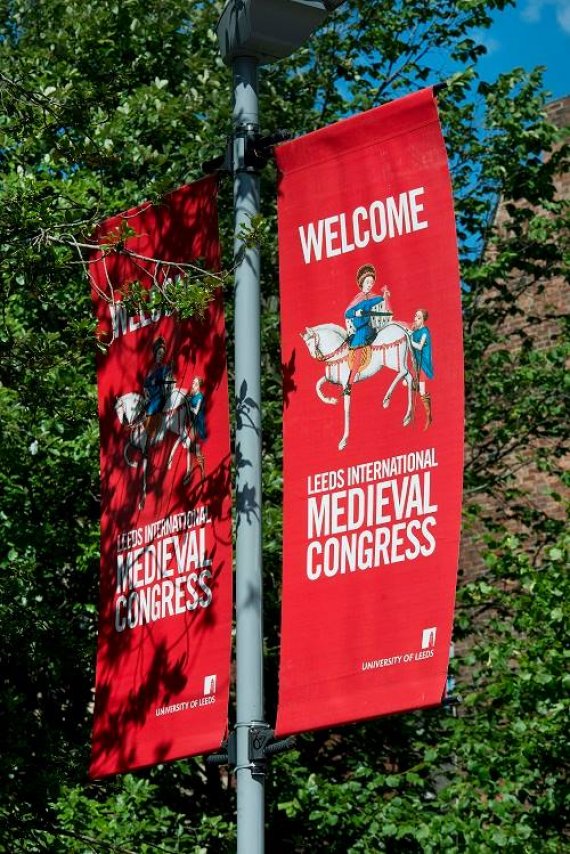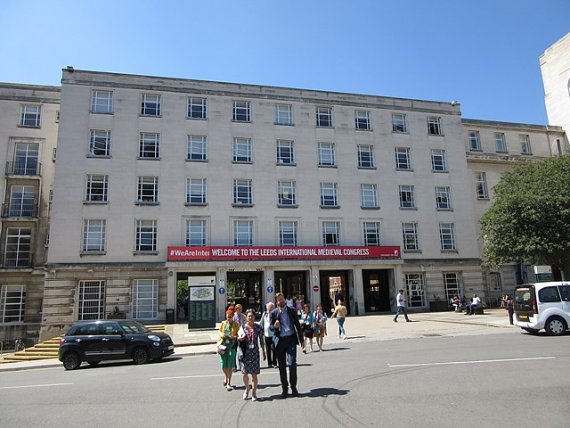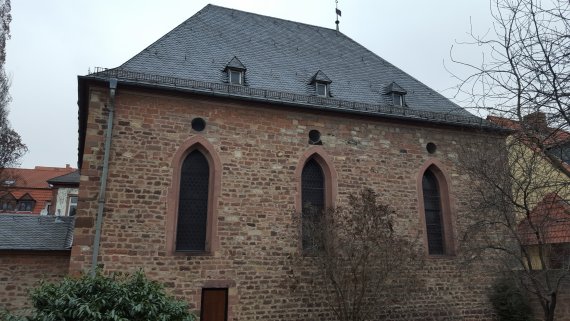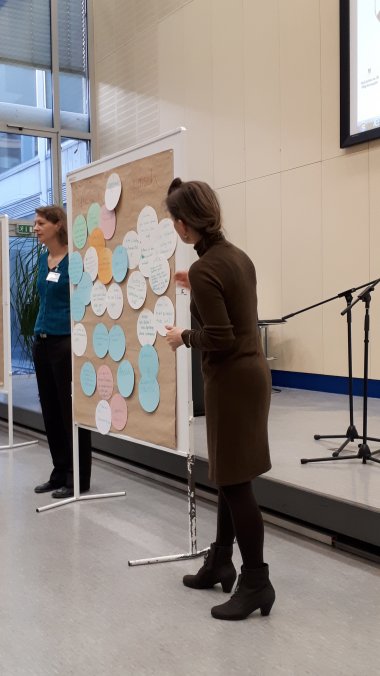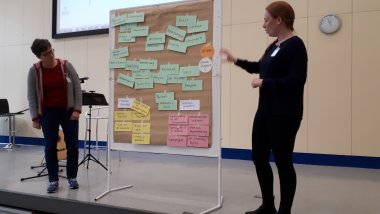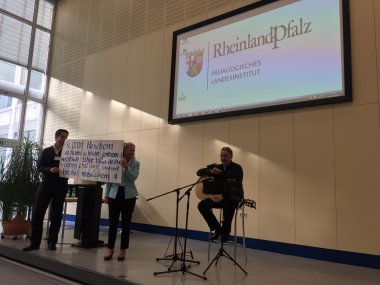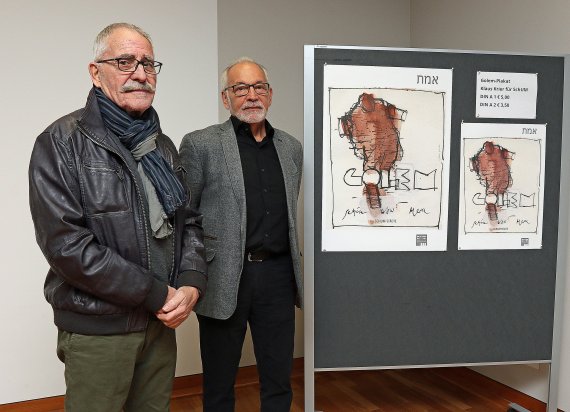Events in Retrospect
Exhibition's opening at Branch of Volksbank Alzey-Worms in Nierstein, January 18, 2018
- Opening of exhibition Wine and Judaism in Nierstein2,08 MiB
- Opening of exhibition Wine and Judaism in Nierstein3,76 MiB
- Flyer Juden und Wein Nierstein2,55 MiB
- Einladung Ausstellung Juden und Wein Nierstein591,25 KiB
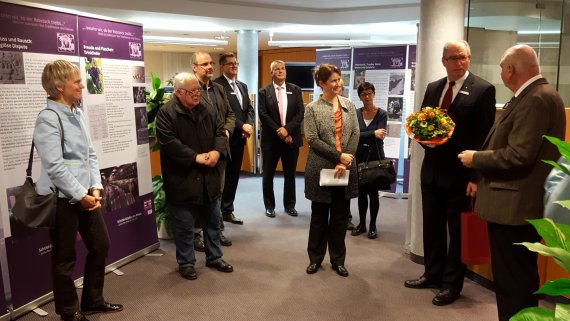
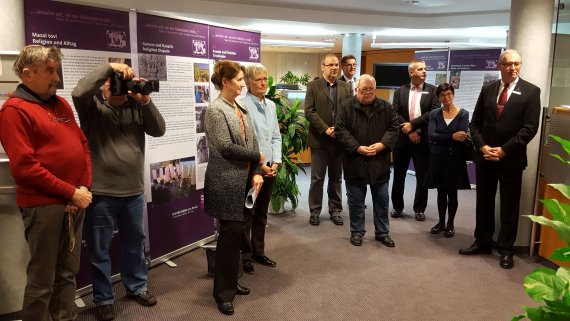
The exhibition of the ShUM-Cities e.V. on Wine and Judaism was opened on 18 January at the Branch of Volksbank Alzey-Wotrms in Nierstein. Mr. Steffan (Board of Directors of the Bank) and the chairman of the historical association Nierstein, Mr. Hexemer, emphasized the importance of a confrontation with Judaism and the Shoah. Susanne Urban talked about the connection between wine and Jewish holidays, quotes from the Hebrew Bible, and Rashi's commentaries, which are the wine of the Torah, as a 17th-century rabbi emphasized.
Unveiling of Column at »Buber-View« on cemetery Holy Sands in Worms, January 29, 2018
- Buber-Stela_a5,35 MiB
- Unveiling Column Martin Buber 6,35 MiB
- Unveiling Column Martin Buber 3,59 MiB
- Unveiling Column Martin Buber 3,28 MiB
Stele on cemetery Holy Sand marks famous Martin Buber-View
Unveiling as part of the Day of Remembrance of the Victims of National Socialism on January 27, 2018
In a conversation between Buber and the Protestant theologian Karl Ludwig Schmidt on January 14, 1933 at the Jewish Lehrhaus in Stuttgart, they discussed the question of the covenant between God and the Jews. Buber sought dialogue on the thesis of the »old and new covenant« and later wrote this down in a text. It states: »And then I walk over to the Jewish cemetery. It consists of crooked, broken, shapeless gravestones, without any direction. I put myself there, and then I look up from this confusion to a wonderful harmony... I stood there, was united with the ashes and right across them with the ancestors. … I stood there and… all the ruptures, all this silent woe is mine; but the covenant has not been revoked… The cathedral is as it is. The cemetery is as it is. But we have not been rejected.« (Martin Buber, in: Theologische Blätter 12 (1933) 272f.)
The location Bubers when viewing the cathedral and Jewish cemetery is marked. In the UNESCO application this perspective plays a role; it is placed under protection as a historical visual axis.
Mayor Kissel, Worms: »The connection of the Jewish and Christian religion in our city is particularly clear at this point. Here we see the togetherness and at the same time the shadows of anti-Jewish and anti-Semitic epochs. Buber reminds us. Today Worms is a city where people of different faiths live peacefully together.«
Rabbi Vernikovsky, Mainz: »Martin Buber has always been committed to interreligious and intercultural dialogue. He has always sought reconciliation instead of division.«
The stele was financed from the grants of the supporting members of the ShUM-Cities Association.
Lecture Prof. Dr. Alfred Bodenheimer, March 12, 2018
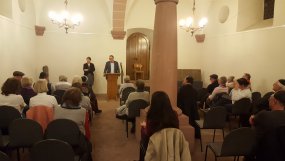
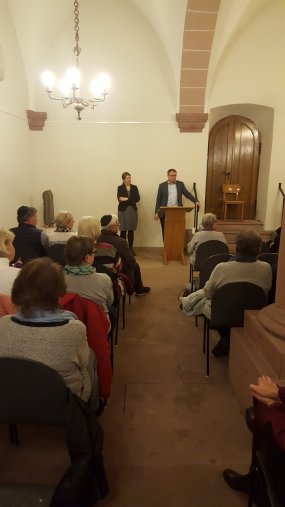
The second to last talk in the series »Interiors - External Perspectives« led Prof. Alfred Bodenheimer from Basel to Worms on March 12, 2018. Born in 1965, Bodenheimer received a traditional Jewish education and conducted Talmud Studies e.g. at Yeshiva University in New York. He habilitated at the University of Geneva and joined the University of Basel in 2003 as Professor of Jewish Literature and Religious History. He is also the author of detective stories about Rabbi Klein. Prof. Bodenheimer once described Worms as the anchor of Jewish history in Germany. Bodenheimer lectured knowledgeably and pointedly on the power of continuity in SchUM, supported by facts and myths, resilience and the indefensibility of Judaism. ShUM is a projection screen for Jews around the world and interweaves ideals and the ideal location of the Jewish - in spite of all destructions and persecutions.
4th Workshop on Information and Visitor Centers in the World Heritage 12., 13. April 2018
- Fourth Workshop on World Heritage Information and Visitor Centers 12./13. April 20185,55 MiB
- Fourth Workshop on World Heritage Information and Visitor Centers 12./13. April 20184,82 MiB
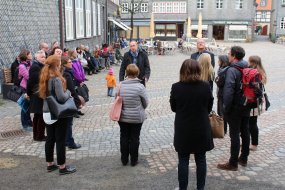
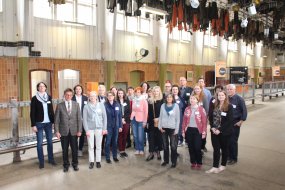
The ShUM-Cities Association were represented by Susanne Flörke at the 4th Workshop on Information and Visitor Centers in the World Heritage in April 2018 in Goslar. The presentation of the processes and milestones in the establishment of a World Heritage Center will help to develop the management plan for the SHUM-Cities and the network and the professional exchange will accompany the ideas and conceptions for ShUM. The ShUM-Cities Ass. now knows: well developed planning processes, clear target group orientation and no competition to existing museums are just as important as the public information that with recognition as a world heritage the work does not end, but really starts!
ShUM-Cities Ass. thanks again for the friendly reception and the good contacts.
Conference »Continuity and Authenticity – On the Memorial Significance of Rebuilt Monuments«, April 17/18, 2018 in Mainz
- Conference Authenticity3,06 MiB
- Conference Authenticity2,09 MiB
- Conference Authenticity4,71 MiB
- Conference Authenticity2,91 MiB
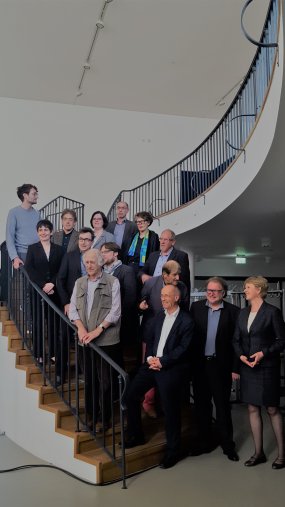
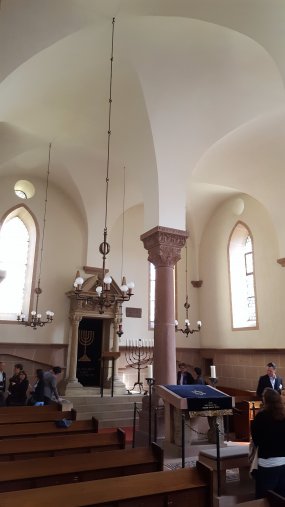
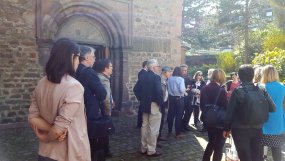
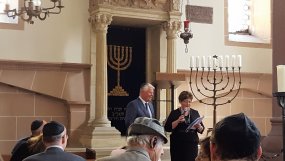
The international conference organized by the Directorate General for Cultural Heritage Rhineland-Palatinate in cooperation with ICOMOS Deutschland on 17th / 18th April 2018 in the Landesmuseum Mainz was closely linked to the UNESCO World Heritage nomination for the ShUM-Cities and aimed at discussing the authenticity of the monuments with regard to the World Heritage application. There was exchange of expertise on aspects of authenticity in view of the monuments that, such as the Worms Synagogue, have not an uninterrupted history. The aim of the conference was to highlight the authenticity of the future World Heritage Sites to be presented in detail for the World Heritage application and to examine the topic from different perspectives. The positive evaluation by numerous, independent, experts from Germany and abroad was a pleasing result. The synagogue Worms does not lack the authenticity. In addition, continuity and religious tradition are mirrored in the various successful efforts to rebuilt the synagogue time and again, the experts underlined. During a visit of the experts in Worms, Anna Kischner, Head of the Jewish Community, Anna Kischner, and Michael Kissel, Mayor of Worms, welcomed them warmly.
The application of ShUM-Cities to UNESCO was taken a further step forward through the conference.
Lecture Dr. Eszter Gantner in Worms, June 28 2018
The last lecture in the series »Interiors - External Perspectives« was presented on June 28, 2018. Gantner to Worms. She studied law, history and political science in Budapest, Jerusalem, Potsdam and Berlin and received her doctorate at the Humboldt University in Berlin. In 2004 and 2008, she was Lecturer and Coordinator of Jewish Studies at Touro College Berlin. Since 2004, she has been teaching at the ELTE University in Budapest, where she was co-founder and research associate of the Center for Central European German-Jewish Culture between 2008-2010. Since January 2017, she is a researcher and coordinator at the Herder Institute. Her publications include e.g.. »Constructed heritage«: The difficult relationship between history and heritage, in: Information on modern urban history 1/2016.
Eszter Gantner spoke in Worms about the definition of spaces as Jewish spaces and their commercialization as a cultural result of European commemoration policies and practices. Space becomes a Jewish space because activities more or less defined as Jewish are performed in or in interaction with it. The rooms are clearly defined - former cemeteries, Jewish quarters, synagogues - but the Jewish often remains absent or only facade, without real Jewish life. Something like that should not happen with SchUM. The dignity of the places should be considered in education, museums and tourism strategies.
Explore, learn, share: A students project in 2018/19
- Katharinen High School Ingolstadt Project ShUM 20183,82 MiB
- Katharinen High School Ingolstadt Project ShUM 20185,61 MiB
- Katharinen High School Ingolstadt Project SchUM 20183,81 MiB
- Katharinen High School Ingolstadt Project ShUM 20185,31 MiB
- Katharinen High School Ingolstadt Project ShUM 20183,61 MiB
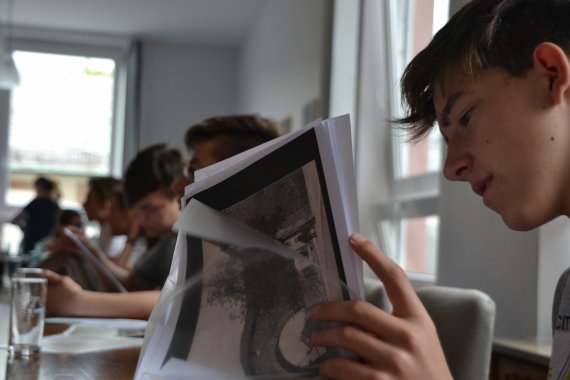
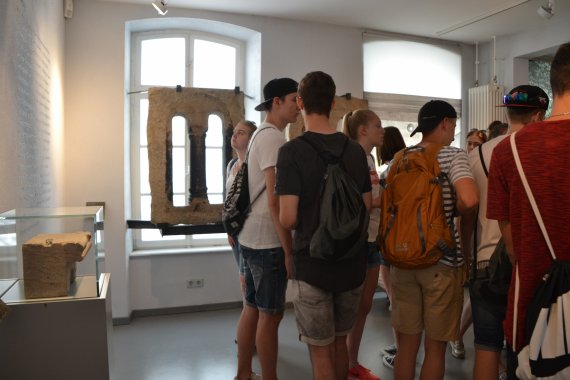
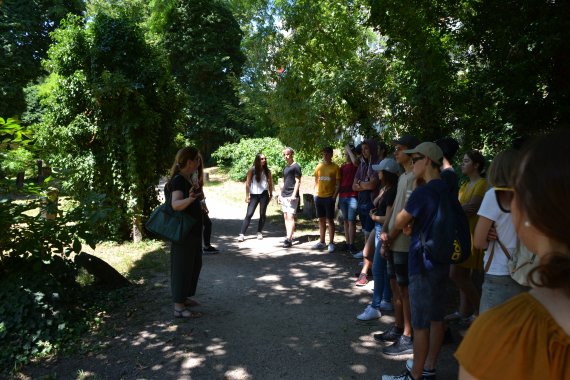
Pupils repeatedly ask themselves when encountering the subject of ShUM: What is that, this SchUM? Who was the Maharam? Why does the synagogue in Worms have an indentation? What do you do in a mikveh? What do gravestones tell about a person? Why was the synagogue in Worms, burned down during the Nazi era in 1938, rebuilt between 1957 and 1961? What's up with the women's synagogues?
A project with the Katharinen-High School Ingolstadt (10th grade), prepared since 2017, accompanied by the teachers Dr. Matthias Schickel and Alexander Schöner, led a 25-member group of 15- to 16-year-olds from Ingolstadt in early July 2018 to Worms and Speyer. Walks through Worms, an excursion to Speyer and an intensive look at the details of buildings and documents prepared the pupils for their own project work.
On the basis of subjects that were illustrated with more than 50 objects, the participants explored these artifacts upon return during a project week. The results of the object research will serve as virtual index cards on the Internet with accompanying educational handouts from 2020 to inform people in German-language educational institutions about SchUM. You can prepare yourself for a visit to SchUM, deal with school in class or adult education and explore the unique aspects of this Jewish life in ShUM on the Rhine in a playful and exploratory way.
International Medieval Congress, July 2018, University of Leeds
At the suggestion of Prof. Eva Frojmovic participation in the conference and a lecture about the synagogue Worms as an icon of the Jewish Middle Ages was possible. The focus was not set on the architecture, but the era between 1933 and 1938 and then the rebuilding process after 1947 were illuminated.
The conference which took place from 2 to 5 July 2018, was packed with a dense program; more than 2,500 participants were active and around 900 panels were offered, as well as excursions, workshops, lecture evenings etc.
The Jewish Middle Ages found expression in many other panels, be it through lectures on the Jewish Middle Ages in Erfurt or Mikvaot.
Jewish Studies/Jewish Heritage : Conferences in Krakow in July and September 2018
- Urban Jewish Heritage - Presence and Absence, Conference 09 2018275,38 KiB
- Urban Jewish Heritage - Presence and Absence, Conference 09 2018423,32 KiB
- Urban Jewish Heritage - Presence and Absence, Conference 09 2018363,94 KiB
- Urban Jewish Heritage - Presence and Absence, Conference 09 2018363,94 KiB
- Future of Religious Herittage Torch Ceremony, Sept. 6 201871,46 KiB
- Old Synagogue Cracow: Worms as role model3,29 MiB
- Old Synagogue Cracow: Worms as role model3,28 MiB
- Old Synagogue Cracow: Worms as role model3,36 MiB
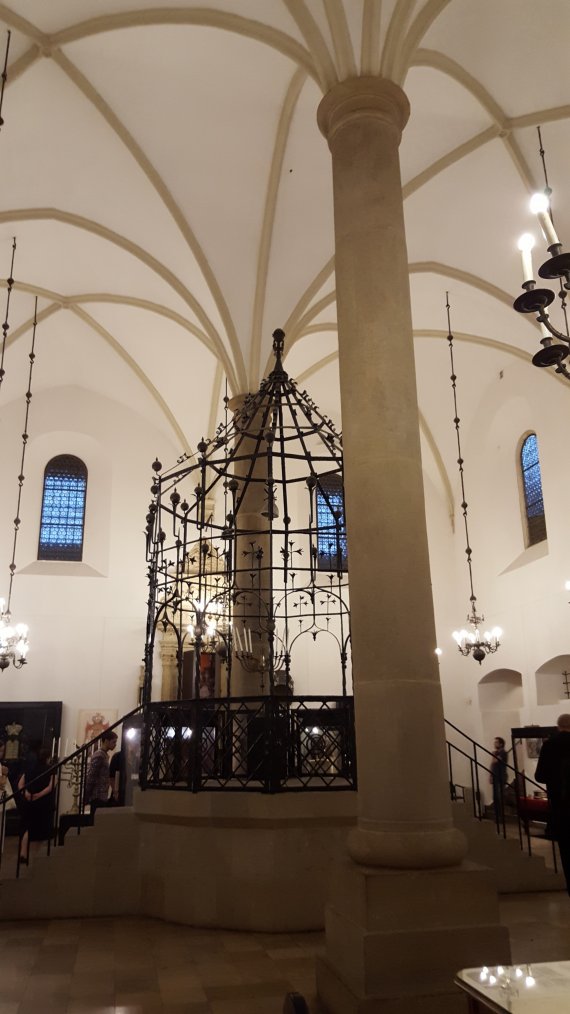
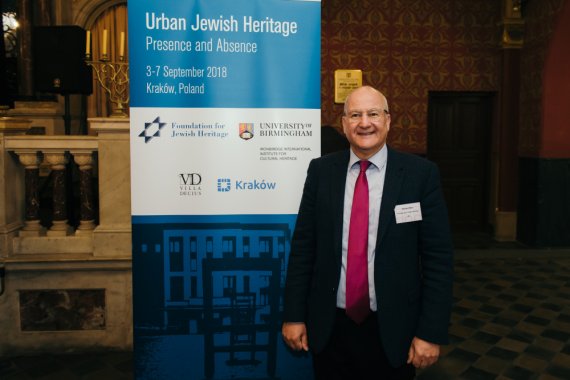
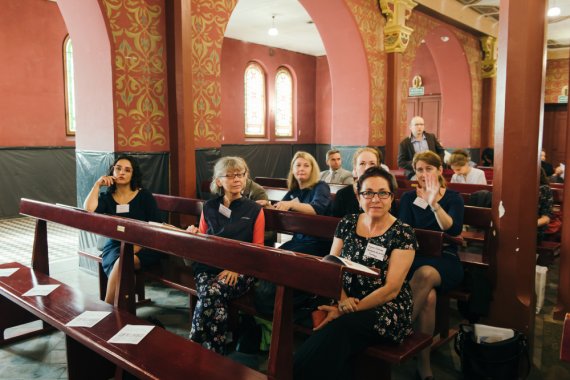
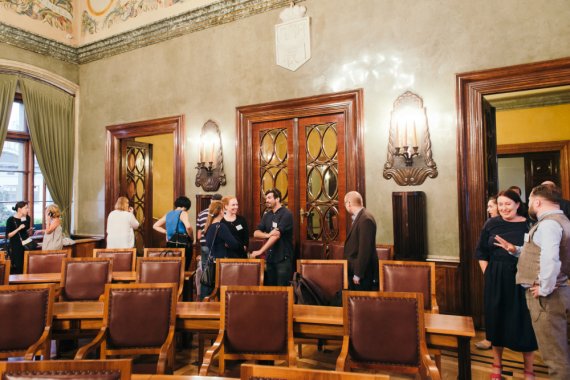
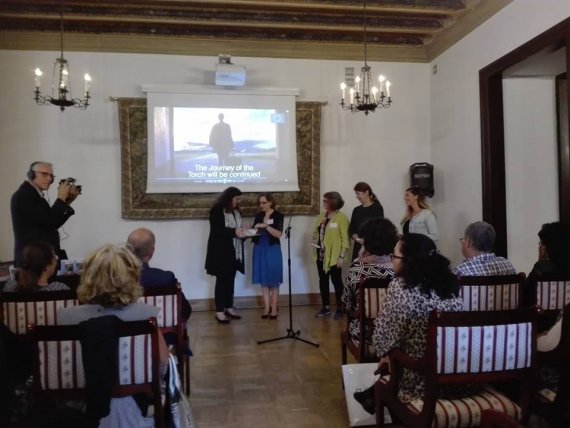
The participation of Susanne Urban and Susnane Flörke from ShUM-Cities Ass. in two conferences in Krakow was extremely inspiring, a huge networking opportunity and a chance to present projects and topics related to the application of the ShUM-Sites for being listed as a World Heritage Site.
In July 2018, the city was the venue for the congress of the European Association of Jewish Studies.
Susanne Urban presented in one of the numerous panels regarding concepts of Remembrance and Museology her lecture.
In September 2018 Krakow was the central meeting point for the conference »Urban Jewish Heritage - Presence and Absence«. Susanne Urban presented potential topics for exhibitions and educational approaches of ShUM. Susanne Flörke lectured about the history of the cemetery »Judensand« in Mainz and how this space was managed and presented throughout th e past 100 years and what the future plans are.
Last but not least: the old synagogue in Krakow, built after the role model of the medieval synagogue in Worms, was worth more than one visit.
Workshop »A World Heritage Center for Worms«, October 11, 2018, Worms
The workshop brought together representatives from tourism, the three cities Speyer, Worms and Mainz, the Schum-Städte e.V. and the Raschi-Haus with initiators and designers of UNESCO World Heritage Visitor Centers as well as Jewish museums in Germany. Dr. Marie-Luise Frey reported on the UNESCO Visitor Center of the Messel Pit. Subsequently, Susanne Hauer presented the UNESCO visitor center in Regensburg. Then Volker Böhm reported on the projects of the agency hneun, whose staff, among other projects, design the UNESCO Visitor Center in Bamberg. An inspection of the area around the Rashi house and the synagogue led to a discussion of the future potential location of such a visitor center. Afterwards, three working groups were discussed. The impulses from the Jewish museums will also be incorporated into the plans for the SchUM special exhibition in the Raschi Haus 2020 and feedback is expected. The workshop was also supported by a donation from the »Gut. Für die Rregion« the Sparkasse Worms-Alzey-Ried allows.
Conference »Religious Heritage – Europe’s Legacy for the Future«, 11 to 13 October 2018, Paris
- Paris FRH Conference October 2018349,70 KiB
- Paris FRH Conference October 20183,12 MiB
- Program FRH Conference Oct 20182,25 MiB
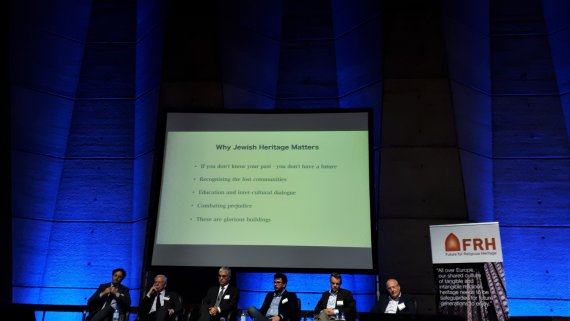

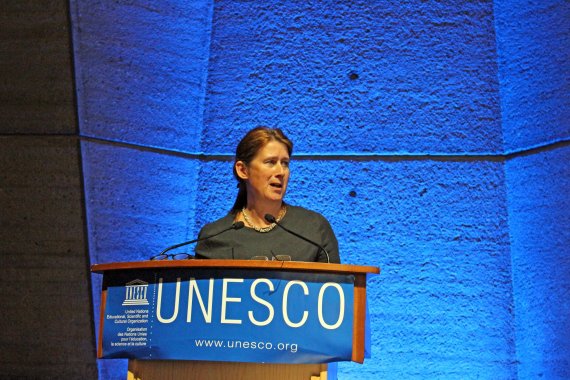
The Paris conference was a forum for both political discussions and the exchange of knowledge between heritage and cultural professionals and religious heritage in Europe. The event provided a unique opportunity for participants to discuss issues surrounding Europe's religious heritage. It was about the cultural, social, economic and spiritual significance of the religious heritage. Measures to promote religious tourism were discussed as well as the appropriate and future use of listed buildings. The Jewish topic was represented by ShUM-Cities Ass. and our close partners, the Foundation for Jewish Heritage, London, notably Michael Mail, and Ruth Ellen Gruber, director of the Jewish Heritage Online project.
https://www.frh-europe.org/
Lecture in the former Synagogue in Deidesheim, October 21,2018
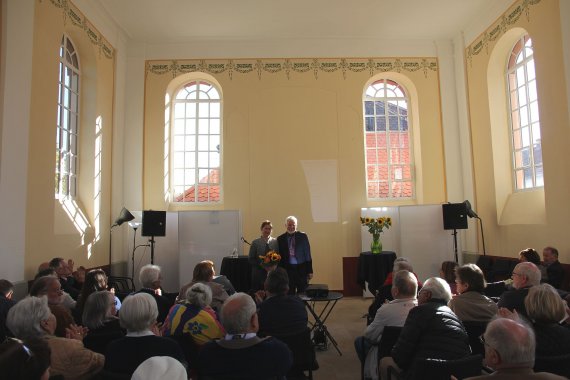
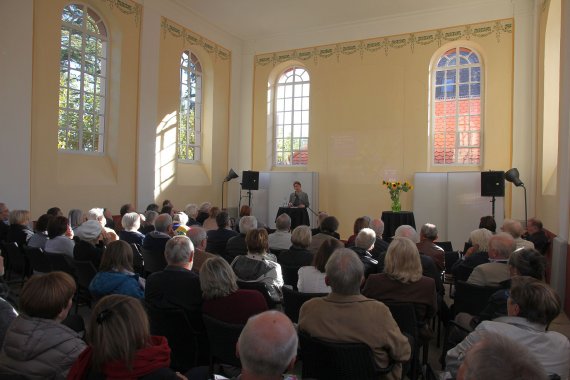
On a friendly late summer morning people were invited to a lecture in the former Synagogue Deidesheim about the subject of »Judaism, Wine and Schum«. The lecture which included many photos and quotes was listened by about 80 interested people. A lively discussion about the Song of Songs, the Hebrew Bible, kosher wine and enjoyment followed. The former Synagogue Deidesheim e.V. invited the public in cooperation with the State Office for Political Education Rhineland-Palatinate.
Teacher Training: »Jewish Heritage along the Rhine: Encounters with ShUM and living Jewish Traditions in teaching classes«, November 6, 2018 in Speyer
On November 6, 2818, the Pedagogical State Institute Rhineland-Palatinate organized in cooperation with the ShUM-Cities Ass. a symposium for teachers on the subject of Jewish heritage on the Rhine. Encounters with ShUM and the living Jewish tradition in teaching practice «. Around 60 teachers from Rhineland-Palatinate schools, from elementary school to high school, took part in the conference and received suggestions for integrating the topic into their lessons. Susanne Urban and Susanne Flörke from the ShUM-Cities Ass. offered workshops on the topics »Golem« and »Water in Judaism«. Other topics of expert referees included: Women in ShUM" (Gabriele Schlick-Bamberger, Jeshurun Religious School Frankfurt am Main), »Jewish Myths and Miracle Stories« (Marion Feise, including the Jewish Museum Berlin) or a workshop on mediation of Jewish images in textbooks (Dr. Martin Liepach, Pedagogical Center Frankfurt am Main). In addition, Cantor Daniel Kempin presented Jewish and Yiddish songs related to ShUM, Ashkenaz and the workshop topics.
The workshops were very well received and it became apparent that the teachers present showed great interest in the topic, which was expressed through lively discussions and suggestions for further cooperation. We appreciated the active participation and will include the results in our educational work as well as the UNESCO application. We sincerely thank you for the cooperation of the teachers and the great organization by the team of the Pedagogical State Institute!
Since October 1, 2018, SchUM-Cities Ass. has repeatedly announced: Golem is returning! Mayor Michael Kissel, chairman of SchUM-Cities Ass. had presented the Golem Art Poster created by Worms artist Klaus Krier. On November 29, 2018, the time had come, and those present at the Worms conference center learned what connection Golem has to Worms. Susanne Urban said that the idea of a protective being, formed out of a lump of clay and brought to life by means of letters and number combinations, originally came from Worms. The scholar Eleazar ben Jehuda Kalonymos had described in his commentary on the ancient »book of creation« for the first time the creation of a golem.
Prof. Dr. Frank Stern from the University of Vienna then reported knowledgeably and with wonderfully fine humor about the »legend of the Jewish artificial super-being«. Stern took the listeners on a journey through time and space, started with a superwoman, meandered through Jewish literature, traveled to Superman in the USA, and asked if a golem could be female. He ended with the introduction to the film »Ex Machina«, which was subsequently screened. After all, modern robots, androids and cyborgs are nothing but golems. The project was also supported by a donation from the foundation »Gut. For the region« from the Sparkasse Worms-Alzey-Ried.

